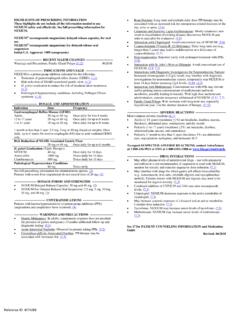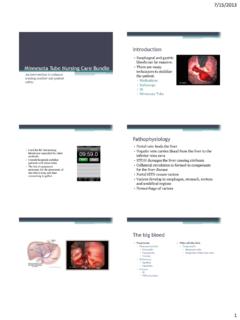Transcription of Case #9: Gastroesophageal Reflux Disease
1 Meghan Ames Mrs. Matuszak KNH 406. February 1, 2010. Case #9: Gastroesophageal Reflux Disease Case Questions I. Understanding the Disease and Pathophysiology 1. How is acid produced and controlled within the gastrointestinal tract? Hydrochloric acid (HCl) is released from parietal cells in the stomach lining in response to histamine, gastrin, and acetyl choline (ACh). Somatostatin inhibits histamine, and thus secretion of HCl when pH falls. HCl is secreted during the cephalic and gastric phases of digestion.
2 During the intestinal phase, HCl secretion slows. The stimulation of gastric juices can result from the presence of protein, distention of the stomach, caffeine, and alcohol. 2. What role does lower esophageal sphincter (LES) pressure play in the etiology of Gastroesophageal Reflux Disease ? What factors affect LES pressure? LES incompetance is a common cause of GERD. A lower LES pressure can allow the Reflux of gastric contents. LES pressure can be lowered as a result of increased secretion of gastrin, estrogen, or progesterone; medical conditions, such as a hiatal hernia or scleroderma; cigarette smoking; use of dopamine, morphine, and theophylline.
3 And presence of foods high in fat, chocolate, spearmint, peppermint, alcohol, and caffeine. 3. What are the complications of Gastroesophageal Reflux Disease ? Some symptoms of GERD include dysphagia, heartburn, increased salivation, belching, and pain in the back, neck, or jaw. If untreated, GERD can result in impaired swallowing, aspiration of gastric contents into the lungs, ulceration and perforation of esophagus. The most severe result of GERD is Barrett's Esophagus. 4. What is H. pylori, and why did the physician want to biopsy the patient for H.
4 Pylori? Helicobacter pylori (H. pylori) is a bacteria that can infect the stomach and lead to gastritis. The physician wants to biopsy Mr. Nelson to determine whether or not this infection is the cause of his symptoms. 5. Identify the patient's signs and symptoms that could suggest the diagnosis of Gastroesophageal Reflux Disease . Heart burn, indigestion, sensitivity to fried foods. 6. Describe the diagnostic test performed for this patient. Barium esophagram is an x-ray of the esophagus after the pt. swallows barium.
5 The x-ray can show ulcers and strictures that may be present with GERD. pH monitoring records the pH of the esophagus in order to determine whether or not stomach contents are refluxing into the esophagus. The data is collected using a catheter that is inserted through the pts. nose and placed just above the LES. 7. What risk factors does the patient present with that might contribute to his diagnosis? (Be sure to consider, lifestyle, medical, and nutritional factors.). Chronic use of aspirin and ibuprofen.
6 Diet high in fat. Alcohol consumption. Decreased physical activity. 8. The MD has decreased this patient's dose of daily aspirin and recommended discontinuing his ibuprofen. Why? How do aspirin and NSAIDs affect Gastroesophageal Disease ? Ibuprofen and aspirin are both non-steroidal antiinflammatory drugs (NSAID) that can result in a decrease in mucosal lining leading to gastritis or peptic ulcer Disease . NSAIDs can increase symptoms associated with GERD due to their impact on the mucosal lining of the stomach.
7 9. The MD has prescribed lansoprazole. What class of medication is this? What is the basic mechanism of the drug? What other drugs are available in this class? What other groups of medications are used to treat GERD? Lansoprazole is a proton pump inhibitor (PPI) used to treat GERD. PPIs decrease the production of acid in the stomach, thus relieving symptoms associated with GERD. In addition to lansoprazole (Prevacid), omeprazole (Prilosec), pantoprazole (Protonix), rabeprazole (Aciphex), and esomeprazole (Nexium) are other PPI.
8 Drugs available by Rx. Other groups of medications used to treat GERD include antacids, foaming agents, H2 blockers, and prokinetics. II. Understanding the Nutrition Therapy 10. Are there specific foods that may contribute to GERD? Why or why not? Foods high in fat, chocolate, spearmint, peppermint, alcohol, and caffeine can result in GERD symptoms. These foods cause symptoms by lowering LES. pressure and/or relaxing the LES. 11. Summarize the current recommendations for nutrition therapy in GERD. Decrease gastric acidity by avoiding black/red pepper, coffee, alcohol, and the consumption of large quantities of food in a single sitting.
9 Avoid foods that lower LES pressure, such as chocolate, mint, and high fat foods. III. Nutrition Assessment A. Evaluation of Weight/Body Composition 12. Calculate this patient's percent UBW and BMI. What does this assessment of weight tell you? In what ways does this contribute to his diagnosis? ht. = 5'9 = m wt. = 215 lbs. = 98 kg UBW = 160. % UBW = 130%. BMI = 32; pt. is class I obese Obesity satisfies several criteria for a causal association with GERD and some of its complications. ( ). B. Calculation of Nutrient Requirements 13.
10 Calculate energy and protein requirements for Mr. Nelson. Identify the formula/calculation method you used, and explain the rationale for using it. Mifflin-St. Jeor: 1839 x = 2942. Harris Benedict: 1964 x = 3124. Quick Estimate: 2352 x = 3764. Average EER = 3277. To find an average EER, I compiled the results from three resting energy expenditure calculations and used a PAL of because Mr. Nelson's job is seated with some movement. C. Intake Domain 14. Complete a computerized nutrient analysis for the patient's usual intake and 24- hour recall.







